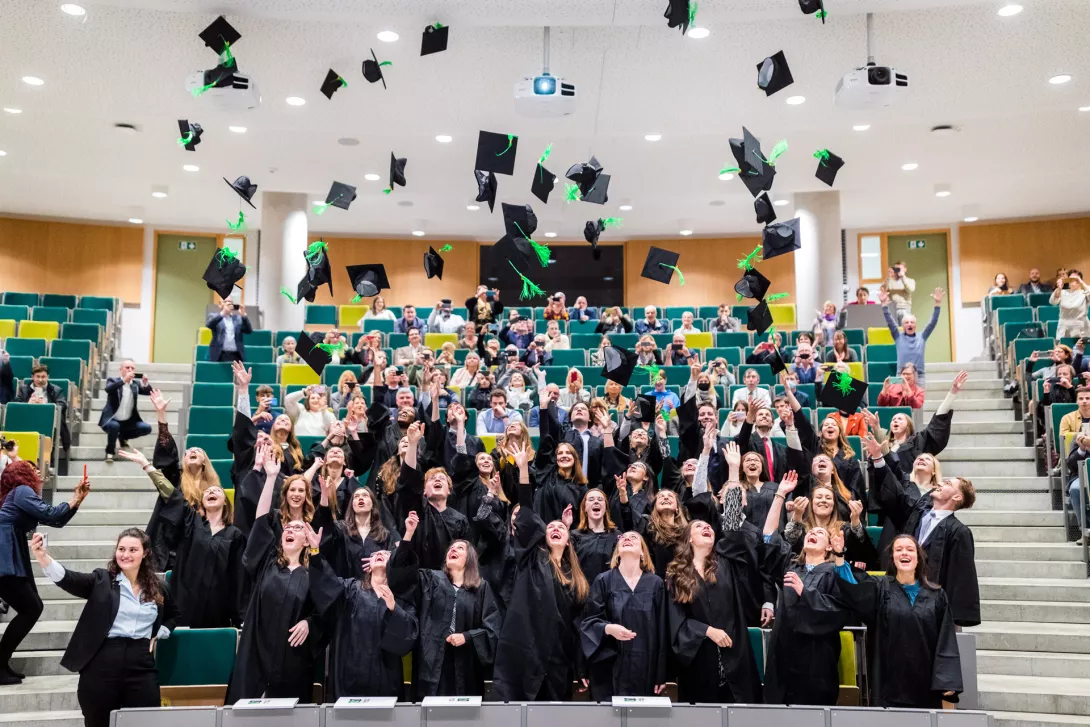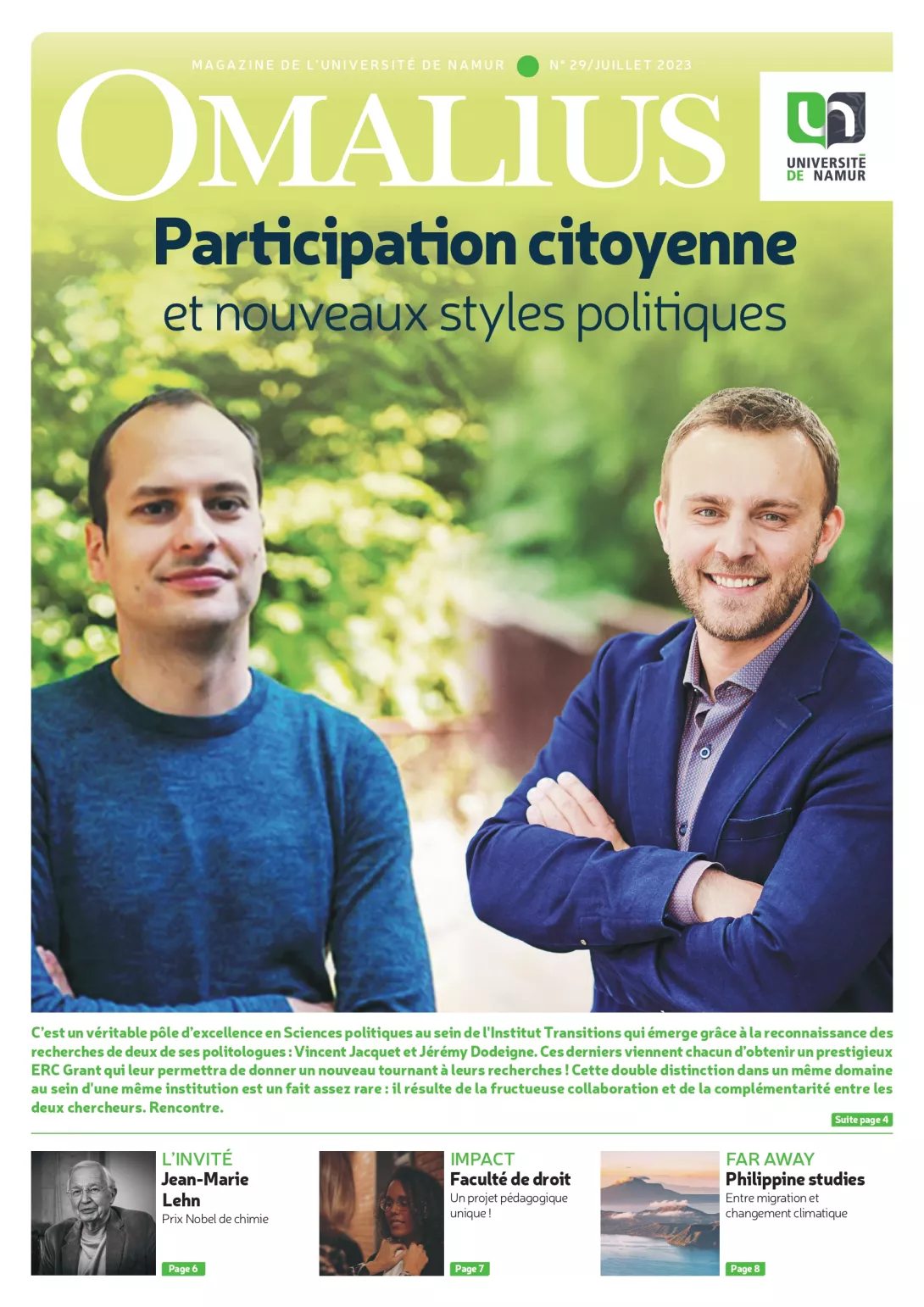
This article is taken from the "Challenges" section of the #29 Omalius magazine (July 2023).
In anticipation of the development of new digital tools, UNamur wanted to gain a better understanding of how future students perceive it, and how they decide to study there... or not. With this in mind, an image study was carried out by 16 students on a research methods course, under the guidance of Pietro Zidda, Professor and Dean of the Faculty of Economics, Social Sciences and Management. It was used to draw up a 'perceptual map' and to position the University of Namur in relation to various criteria and in comparison with other universities in the French community. Were the results surprising? "Yes and no", says Pietro Zidda. "There are, of course, a number of things that we already knew. We expected to have a good image, but perhaps not on this scale. In particular, it emerged that UNamur came out on top in terms of proximity and conviviality, which everyone agrees is part of the institution's DNA."
Innovative and inclusive
The second salient finding concerns the quality of teaching and programmes. "It seems to be common knowledge that someone who comes from UNamur finds a job easily", comments Pietro Zidda. "Just because we're a small university doesn't mean we can't offer excellent teaching", insists François-Xavier Fiévez, Vice-Rector for Student Affairs. UNamur stands out for its innovative teaching methods, as Marc Romainville, head of the university teaching department, points out: "A turning point has been reached: teaching is not just about being attentive to the student, but also about offering original teaching experiences", he sums up. "In addition to lectures, some teachers are developing truly innovative methods, for example through role-playing, as in political science, where students were invited to put themselves in the shoes of Members of Parliament as part of a European negotiation on vaccines." It is against this backdrop of educational change that the UNamur library is now undergoing its metamorphosis into a learning centre. "The idea is to go beyond the concept of shelves of books with tables and chairs to create spaces where students can work while sharing and learning in groups," explains François-Xavier Fiévez.
UNamur also enjoys a very good image when it comes to respect for minorities and cultural diversity. "We are a hospitable university, with a great deal of thought given to foreign students, migrants and so on," explains François-Xavier Fiévez. "We try to help them master the French language and ensure that they mix well with others. We have also developed contacts with circles of international students to give them visibility and federate them through different actions". Similarly, UNamur has spared no effort in adapting to people with special needs, which is reflected in the survey by its reputation for "social responsibility". Another cross-cutting finding of the survey is that the more familiar the respondents were with UNamur, the better their image of the organisation. So the reality on the ground matches its reputation.
New avenues for development
Where the study highlights areas for development for UNamur is in relation to its size and associated infrastructure. "There's sometimes this idea that it's better to go to a university where there's 'everything': concert halls, theatres, sports facilities and so on. Namur necessarily has less to offer than a larger city," comments Pietro Zidda. "But at the same time, the city of Namur has undergone a major transformation and has a lot to offer to attract students. There are plenty of opportunities to organise cultural and sporting events at the university and in the town. We're working to raise the profile of all this wealth. That's why we need to communicate more, particularly about what's available in terms of sports facilities. We're not well positioned, even though our students are very happy with what they have", says Pietro Zidda.
This commitment to the city seems all the more relevant.
The elements on which UNamur is well evaluated, in particular the quality of teaching and supervision, are not the determining factors in students' choice of university. "This is precisely what caught our attention," points out Pietro Zidda. "But it's not just the students who make the choice," says Marc Romainville. "Parents and secondary school teachers also contribute to the final decision."
What's more, while UNamur enjoys an excellent general image, it is often beaten - if you take each criterion in isolation - by another university. "This means that if you are looking for a university that has a good image in all areas, UNamur is very well positioned. But if you are looking for the university that is the best on a specific criterion such as sports facilities or international reputation, it won't be the University of Namur," explains Pietro Zidda. On the other hand, the study showed that some universities that are very well positioned on certain criteria have significant weaknesses on others - a wide gap that does not exist in the case of UNamur. UNamur's choice may well reflect a search for balance and rationality. Let's not forget that, more often than not, it's also a choice linked to geographical criteria: studying close to one's parents' home means saving on dormitory expenses. Location therefore also plays an important role in the choice of places to study.
The university in the city and internationally
Finally, UNamur stands out in this survey for its international outlook.
"This shows that all the efforts made to internationalise our programmes are bearing fruit and that the effects are starting to be felt. In my faculty alone, we have no fewer than 42 nationalities among our students and 15 among our professors..." adds Pietro Zidda. Rankings, which UNamur decided to join a few years ago, are one of the tools used to promote this internationalisation.
For Pietro Zidda, it is important for UNamur to continue to build on its strengths without trying to be all things to all people... " It's a bit like Colruyt starting to emphasise quality and raising its prices, at the risk of losing its initial audience". In his opinion, the very fact of carrying out an image study is a positive signal for those who have already been won over... and those who will be convinced in the future. "It shows that the university is listening to its environment, that it is using modern techniques used elsewhere in other universities, that it is trying to evolve, that it is questioning itself", he concludes.
Author: Julie Luong
Image sturvey and method
Most image studies are carried out in the commercial field in order to gain a better understanding of customer expectations and assess the appropriateness of the communication strategy. However, this work can be carried out for any type of entity or institution, such as political parties, the media, etc. "At UNamur, this kind of study had never been carried out in a quantitative way," explains Pietro Zidda, "so we wanted to go further." So he and 16 of his students collected responses from 431 people. "There were three distinct groups: students who had recently arrived at UNamur, rhetoricians who had already obtained information at UNamur and/or were already taking preparatory courses in medicine, for example, and finally rhetoricians who had no connection with us and had not begun their research", he explains.
The interviewees were first asked to say what came to mind when they were told "University of Namur" and when they were told another randomly chosen university. "In this way, the interviewees did not know that the survey was being carried out on behalf of UNamur. We only told them at the end so as not to create halo effects (editor's note: cognitive bias linked to first impressions)". They were then asked to evaluate each of the French-speaking university institutions on 12 criteria selected in advance with the students via a qualitative study.
"A university on a human scale"
Kevin Persoons, the new President of the Assemblée Générale des Étudiants (AGE), gives us his impressions of the results of this survey.
Omalius: UNamur is appreciated for its proximity to students. Is that a real advantage?
Kevin Persoons: Yes, that's clearly what attracts many of us to Namur. Even in large sections, you can have really close contact with the teachers and assistants, which is really interesting. Generally speaking, it's a university on a human scale, which makes it easier for us to get in touch with each other on campus, even between different streams.
O. UNamur also stands out for its international outlook...
K.P.: We have lots of opportunities to travel during our degree course and do work placements abroad. We also welcome a lot of foreign students, including French students who come to study medicine and veterinary medicine in particular. There are also a large number of Flemish students in Namur.

O. Would you say that there is a special quality of life at UNamur?
K.P.: The campus is centrally located, in the centre of the city, which is not the case in Liège or Brussels. In Louvain-la-Neuve, the university is more like the town itself. Here, we're right at the heart of a historic city, with a wealth of resources, greenery and places to walk, which gives you the feeling that you're really living in and with the city.
O. What about campus activities?
K. P.: The AGE coordinates all the student activities and policies on campus, and from there, all the student circles, the project kots as in Louvain-la-Neuve and the Régionales, which promote regional heritage through baptisms in particular. But there are also sports teams, parody shows in the colleges... So there really are a lot of things: enough for every student to find their way around and do something they love on campus!



